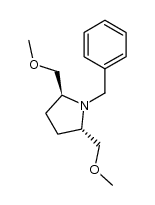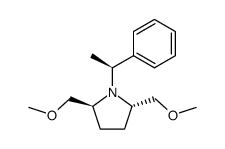90290-05-4
| 中文名 | (R,R)-(-)-2,5-二(甲氧甲基)吡咯烷 |
|---|---|
| 英文名 | (r,r)-(-)-2,5-bis(methoxymethyl)-pyrrolidine |
| 英文别名 |
(2R,5R)-2,5-dimethoxymethylpyrrolidine
MFCD00210015 (S,S)-2,5-bis(methoxymethyl)pyrrolidine (-)-2,3,4,5-Tetradeoxy-2,5-imino-1-O,6-O-dimethyl-L-threo-hexitol (R,R)-2,5-bis(methoxymethyl)pyrrolidine (2R,5R)-bis(methoxymethyl)pyrrolidine (R,R)-2,5-di-(methoxymethyl)pyrrolidine [2R,5R,(-)]-2,5-Bis(methoxymethyl)pyrrolidine |
| 密度 | 0.922g/cm3 |
|---|---|
| 沸点 | 197.3ºC at 760mmHg |
| 分子式 | C8H17NO2 |
| 分子量 | 159.22600 |
| 闪点 | 76.2ºC |
| 精确质量 | 159.12600 |
| PSA | 30.49000 |
| LogP | 0.72860 |
| 折射率 | 1.447-1.449 |
| 储存条件 | 在避光阴凉处储存 |
| 稳定性 | 对空气和湿气相对比较稳定 |
| 分子结构 | 1、 摩尔折射率:43.93 2、 摩尔体积(cm3/mol):172.6 3、 等张比容(90.2K):400.5 4、 表面张力(dyne/cm):28.9 5、 极化率(10-24cm3):17.41 |
| 计算化学 | 1、 疏水参数计算参考值(XlogP):0.1 2、 氢键供体数量:1 3、 氢键受体数量:2 4、 可旋转化学键数量:4 5、 互变异构体数量: 6、 拓扑分子极性表面积(TPSA):35.1 7、 重原子数量:11 8、 表面电荷:1 9、 复杂度:96.3 10、同位素原子数量:0 11、确定原子立构中心数量:2 12、不确定原子立构中心数量:0 13、确定化学键立构中心数量:0 14、不确定化学键立构中心数量:0 15、共价键单元数量:1 |
| 更多 | 1. 性状:无色液体 2. 沸点(ºC,15 mmHg):110~115 3. 溶解性:溶于大多数有机溶剂。 |
Synonym:None Known Section 2 - COMPOSITION, INFORMATION ON INGREDIENTS
Risk Phrases: None Listed. Section 3 - HAZARDS IDENTIFICATION EMERGENCY OVERVIEW
The toxicological properties of this material have not been fully investigated. Potential Health Effects Eye: May cause eye irritation. Skin: May cause skin irritation. Ingestion: May cause irritation of the digestive tract. The toxicological properties of this substance have not been fully investigated. Inhalation: May cause respiratory tract irritation. The toxicological properties of this substance have not been fully investigated. Chronic: No information found. Section 4 - FIRST AID MEASURES Eyes: Flush eyes with plenty of water for at least 15 minutes, occasionally lifting the upper and lower eyelids. Get medical aid. Skin: Get medical aid. Flush skin with plenty of water for at least 15 minutes while removing contaminated clothing and shoes. Wash clothing before reuse. Ingestion: Never give anything by mouth to an unconscious person. Get medical aid. Do NOT induce vomiting. If conscious and alert, rinse mouth and drink 2-4 cupfuls of milk or water. Inhalation: Remove from exposure and move to fresh air immediately. If not breathing, give artificial respiration. If breathing is difficult, give oxygen. Get medical aid. Notes to Physician: Section 5 - FIRE FIGHTING MEASURES General Information: As in any fire, wear a self-contained breathing apparatus in pressure-demand, MSHA/NIOSH (approved or equivalent), and full protective gear. During a fire, irritating and highly toxic gases may be generated by thermal decomposition or combustion. Vapors may be heavier than air. They can spread along the ground and collect in low or confined areas. Runoff from fire control or dilution water may cause pollution. Extinguishing Media: Use agent most appropriate to extinguish fire. Use water spray, dry chemical, carbon dioxide, or appropriate foam. Section 6 - ACCIDENTAL RELEASE MEASURES General Information: Use proper personal protective equipment as indicated in Section 8. Spills/Leaks: Absorb spill with inert material (e.g. vermiculite, sand or earth), then place in suitable container. Avoid runoff into storm sewers and ditches which lead to waterways. Clean up spills immediately, observing precautions in the Protective Equipment section. Provide ventilation. Section 7 - HANDLING and STORAGE Handling: Wash thoroughly after handling. Remove contaminated clothing and wash before reuse. Use with adequate ventilation. Avoid contact with eyes, skin, and clothing. Keep container tightly closed. Avoid ingestion and inhalation. Storage: Keep container closed when not in use. Store in a tightly closed container. Store in a cool, dry, well-ventilated area away from incompatible substances. Section 8 - EXPOSURE CONTROLS, PERSONAL PROTECTION Engineering Controls: Facilities storing or utilizing this material should be equipped with an eyewash facility and a safety shower. Use adequate ventilation to keep airborne concentrations low. Exposure Limits CAS# 90290-05-4: Personal Protective Equipment Eyes: Wear appropriate protective eyeglasses or chemical safety goggles as described by OSHA's eye and face protection regulations in 29 CFR 1910.133 or European Standard EN166. Skin: Wear appropriate protective gloves to prevent skin exposure. Clothing: Wear appropriate protective clothing to prevent skin exposure. Respirators: Follow the OSHA respirator regulations found in 29 CFR 1910.134 or European Standard EN 149. Use a NIOSH/MSHA or European Standard EN 149 approved respirator if exposure limits are exceeded or if irritation or other symptoms are experienced. Section 9 - PHYSICAL AND CHEMICAL PROPERTIES Physical State: Liquid Color: clear, colorless Odor: Not available. pH: Not available. Vapor Pressure: Not available. Viscosity: Not available. Boiling Point: Not available. Freezing/Melting Point: Not available. Autoignition Temperature: Not applicable. Flash Point: Not applicable. Explosion Limits, lower: Not available. Explosion Limits, upper: Not available. Decomposition Temperature: Solubility in water: Specific Gravity/Density: Molecular Formula: C8H17NO2 Molecular Weight: 159.23 Section 10 - STABILITY AND REACTIVITY Chemical Stability: Stable under normal temperatures and pressures. Conditions to Avoid: Incompatible materials, excess heat, strong oxidants. Incompatibilities with Other Materials: Oxidizing agents. Hazardous Decomposition Products: Nitrogen oxides, carbon monoxide, irritating and toxic fumes and gases, carbon dioxide, nitrogen. Hazardous Polymerization: Has not been reported Section 11 - TOXICOLOGICAL INFORMATION RTECS#: CAS# 90290-05-4 unlisted. LD50/LC50: Not available. Carcinogenicity: (R,R)-(-)-2,5-Bis(Methoxymethyl)Pyrrolidine - Not listed by ACGIH, IARC, or NTP. Section 12 - ECOLOGICAL INFORMATION Section 13 - DISPOSAL CONSIDERATIONS Dispose of in a manner consistent with federal, state, and local regulations. Section 14 - TRANSPORT INFORMATION IATA Not regulated as a hazardous material. IMO Not regulated as a hazardous material. RID/ADR Not regulated as a hazardous material. Section 15 - REGULATORY INFORMATION European/International Regulations European Labeling in Accordance with EC Directives Hazard Symbols: Not available. Risk Phrases: Safety Phrases: S 24/25 Avoid contact with skin and eyes. WGK (Water Danger/Protection) CAS# 90290-05-4: No information available. Canada None of the chemicals in this product are listed on the DSL/NDSL list. CAS# 90290-05-4 is not listed on Canada's Ingredient Disclosure List. US FEDERAL TSCA CAS# 90290-05-4 is not listed on the TSCA inventory. It is for research and development use only. SECTION 16 - ADDITIONAL INFORMATION N/A |
| 危害码 (欧洲) | Xi: Irritant; |
|---|---|
| 风险声明 (欧洲) | 36/37/38 |
| 安全声明 (欧洲) | 24/25-36-26 |
|
~% 
90290-05-4 |
| 文献:European Journal of Medicinal Chemistry, , vol. 64, p. 562 - 578 |
|
~86% 
90290-05-4 |
| 文献:Yamamoto; Hoshino; Fujimoto; Ohmoto; Sawada Synthesis, 1993 , # 3 p. 298 - 302 |
|
~87% 
90290-05-4 |
| 文献:Ahman, Jens; Somfai, Peter Tetrahedron, 1992 , vol. 48, # 43 p. 9537 - 9544 |
|
~% 
90290-05-4 |
| 文献:Tetrahedron Letters, , vol. 25, # 8 p. 857 - 860 |









